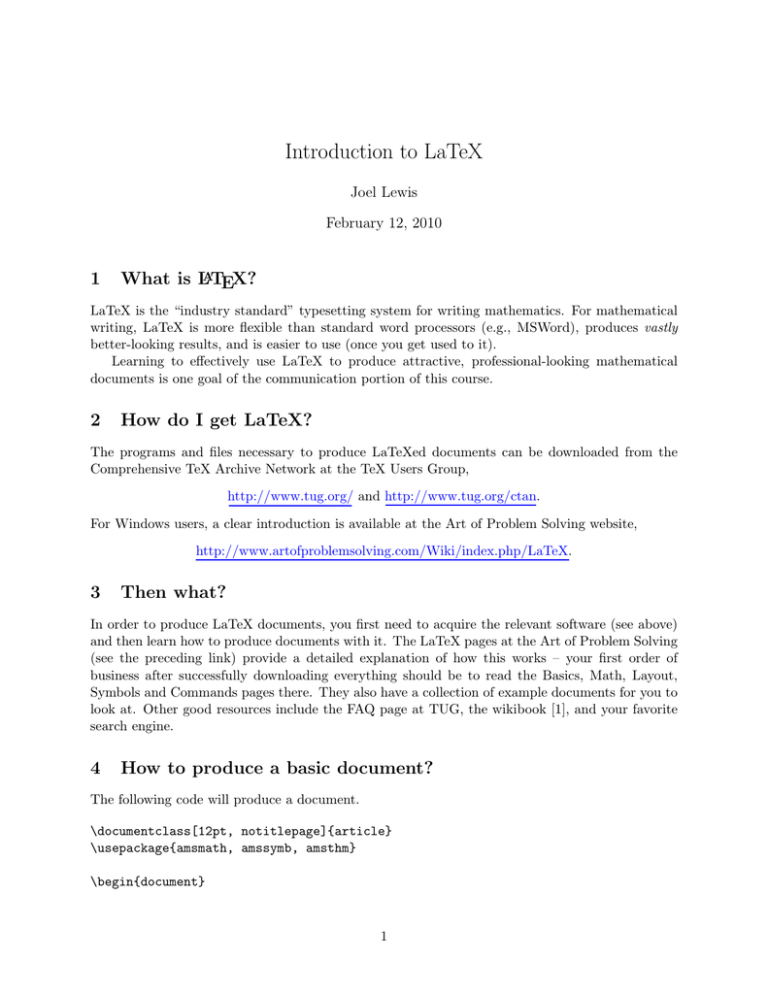Document 13426252
advertisement

Introduction to LaTeX
Joel Lewis
February 12, 2010
1
What is LATEX?
LaTeX is the “industry standard” typesetting system for writing mathematics. For mathematical
writing, LaTeX is more flexible than standard word processors (e.g., MSWord), produces vastly
better-looking results, and is easier to use (once you get used to it).
Learning to effectively use LaTeX to produce attractive, professional-looking mathematical
documents is one goal of the communication portion of this course.
2
How do I get LaTeX?
The programs and files necessary to produce LaTeXed documents can be downloaded from the
Comprehensive TeX Archive Network at the TeX Users Group,
http://www.tug.org/ and http://www.tug.org/ctan.
For Windows users, a clear introduction is available at the Art of Problem Solving website,
http://www.artofproblemsolving.com/Wiki/index.php/LaTeX.
3
Then what?
In order to produce LaTeX documents, you first need to acquire the relevant software (see above)
and then learn how to produce documents with it. The LaTeX pages at the Art of Problem Solving
(see the preceding link) provide a detailed explanation of how this works – your first order of
business after successfully downloading everything should be to read the Basics, Math, Layout,
Symbols and Commands pages there. They also have a collection of example documents for you to
look at. Other good resources include the FAQ page at TUG, the wikibook [1], and your favorite
search engine.
4
How to produce a basic document?
The following code will produce a document.
\documentclass[12pt, notitlepage]{article}
\usepackage{amsmath, amssymb, amsthm}
\begin{document}
1
Hello world! It is not true that $2 + 2 = \sin(5 \pi^2)$, but
\[
\sum_{n = 1}^{10} n = \frac{10 \cdot 11}{2}
\]
is better.
LaTeX
does
words, and
for
single
line
breaks.
not
will
care
ignore
how
much space you
extra
space. Ditto
put
between
(Two or more line breaks starts a new paragraph.)
\noindent No indentation! But \emph{emphasis}!
for more on bibliographies.
And see \cite[\S 7]{wiki}
\begin{thebibliography}{9}
\bibitem{wiki} ‘‘LaTeX’’ on Wikibooks,
\texttt{http://en.wikibooks.org/wiki/LaTeX}.
Accessed January 29, 2010.
\end{thebibliography}
\end{document}
The resulting document will look like this:
Hello world! It is not true that 2 + 2 = sin(5π 2 ), but
10
1
n=1
n=
10 · 11
2
is better.
LaTeX does not care how much space you put between words, and will ignore extra space. Ditto
for single line breaks.
(Two or more line breaks starts a new paragraph.)
No indentation! But emphasis! And see [1, §7] for more on bibliographies.
References
[1] “LaTeX” on Wikibooks, http://en.wikibooks.org/wiki/LaTeX. Accessed January 29, 2010.
2
MIT OpenCourseWare
http://ocw.mit.edu
18.310 Principles of Discrete Applied Mathematics
Fall 2013
For information about citing these materials or our Terms of Use, visit: http://ocw.mit.edu/terms.





